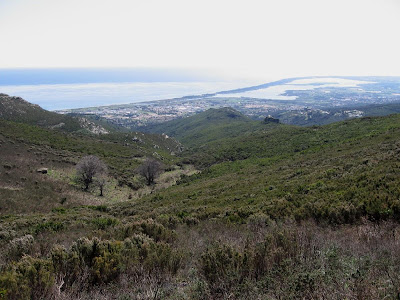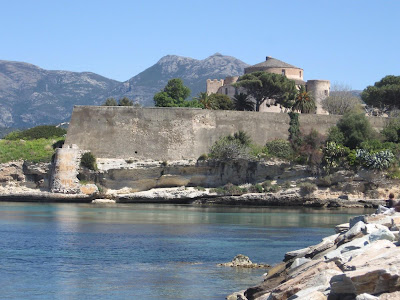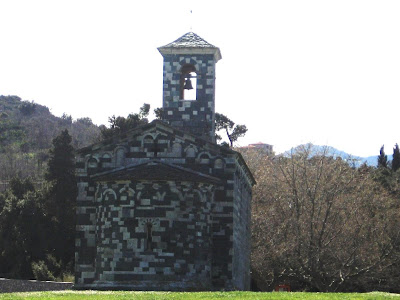Wednesday 7th April 2010, St. Florent, Corsica
As we have travelled around Europe over recent years Ian has enthusiastically marked out our route in different coloured inks according to the series of Modestine's Travels we are blogging. Looking at our Michelin atlas of France we realised the only pages without a colour trail were the pages for Corsica. So we really had no option but to come here and finish colouring in the atlas.
When we last left you we were back in an olive grove in southern France recovering from a shivering night in the Alps and Jill's knees and hips were suffering from aches en Provence. (I'm afraid our blogs are littered with puns if you look for them.)
Yesterday morning, it seems a world away now, we woke to warm sunshine and after hot showers we made our way down into the little town of Oraison to browse the weekly market held in the square around the little church. The air was heavy with the scent of aromatic herbs and lavender mixed with ewes' milk cheeses, dried sausage and olive oil. We bought purple aubergines, red peppers, radishes, carrots and endives while watching the interaction between stall holders and customers, all of whom know each other well. Slices of freshly baked pizza oozing in tomatoes, herbs and olive oil consumed on the church steps in the sunshine was followed by strong coffees on the market square. A stroll around the back streets revealed crumbling facades made bright by pots of plants on window ledges frequently shared with sleeping cats. Faded mauve shutters were closed against the sunshine while little alleyways crossed the narrow streets providing shortcuts to the market place. In the corner of the main square stood the baroque church, its doors thrown open to let in some warm sunny air. Inside the flowers from Easter Sunday were still fresh in their vases around the altar and recorded music added to the tranquillity and contrast with the busy market place outside.

We were reluctant to leave this typical Provence town and unsure which direction to take. We set off towards Toulon where we intended eventually taking the ferry to Corsica, thus avoiding passing through the centre of Marseilles, France's largest port. Rather to our surprise we made far better time than expected and found ourselves sweeping into Toulon at the height of the rush hour. At the port we discovered a ferry was leaving for Bastia in a couple of hours so booked ourselves on. It was easier than finding a campsite and facing Toulon traffic again at a later date and it made no odds to us whether we arrived in Corsica via Bastia or Ajaccio on the opposite side of the island.
Having queued and waited to board the ferry we were stopped at the very last moment by an over conscientious ticket inspector with a tape measure who declared Modestine to be two centimetres over-height and turned us back to rebook. We genuinely had not been trying to get her on board cheaply. We'd been asked her length but not her height. We were obliged to pay an extra 58 euros and by the time we returned to the ferry we were the last to board. There was heaps of headroom and we were surrounded by ordinary cars so we felt victimised. Guess it's the luck of the draw. Another official might have let her through. Unfortunately the delay meant we were fitted on at the top of a steep ramp facing the wrong way for us to exit. Thus Modestine made an undignified entry into Corsica rump first! The further south in Europe we go, the more chaotically organised the ferries become. Greece and Corsica pretty well share top place for mayhem.


By 7.30 this morning we were crawling the streets of Bastia seeking a parking space. There are just too many cars in the town and it is pretty well grid-locked. Eventually we left Modestine near the railway station (only two lines on the island but magnificent rides they must surely be) and walked back into town and along to the old port where we sat with croissants and coffee overlooking the sparking clear water with the fishing boats bobbing at anchor.

Bastia and Ajaccio vie for status as capital of the island. Above Bastia stand the walls of the citadel with an old fortified town within. From up there we had stunning views down onto the port and along the coast towards the lagoon just back from the sea. It must be the only flat land on the island and is also home to Bastia airport. Formerly it was an area of marshland and swamps, swarming with malaria carrying mosquitoes. It was only back in the 1940s that it was sprayed with DDT to eliminate the mosquitoes, drained and made useable.



On the main square of Bastia stands a statue of Napoleon dressed in triumphal roman costume. He is Corsica's most notable hero, born in Ajaccio in 1769. Indeed, his presence is everywhere here. Ian reckoned it would be possible to go around the island staying only in hotels and eating only in restaurants bearing his name.


Bastia has a smart central shopping area and there are large blocks of modern flats built around the edge of the town. Some of the huge older properties around the port have been sympathetically restored and made into flats but there remains much to do. We saw street after street of decayed buildings, their base littered with broken plaster and roof tiles. The residents frequently had stunning views from their shabby apartments but just narrow, dark, wooden stairways to climb, maybe eight floors, to their homes. Washing hung from windows and in general the area reminded us of parts of Italy, Spain and Portugal.
Corsica has had a turbulent history, having been variously occupied or owned by the Greeks, Romans, Vandals, Lombards, the Byzantine empire, the Saracens and the kingdoms of Pisa, Genoa and Aragon as well as France and even Britain for a short period during the 18th century. It has also been variously occupied by Italy and Germany during the Second World War. In 1768 Genoa sold its right to the island to the French, just before the birth of Napoleon. Thus Corsica has actually belonged to France for longer than has the region of Savoy on the mainland!
The Genoese had a reputation for corrupt justice while the Corsicans, particularly away from the coast have always lived a harsh, independent and violent way of life. Thus they took it upon themselves to carry out their own vengeance against perceived wrong-doing.
The vendetta is one of the least savoury aspects of Corsican life and existed until very recent times. Indeed the reputation for feuding between families is claimed to still exist in the more isolated parts of the island. Certainly it was still going on within living memory. Any perceived slight or offence by neighbours could ultimately lead to murder, whereupon vengeance would be taken by the victim's relatives. This would escalate with further murders in which all male members of opposing families would become involved. To the Corsicans it was all a question of honour. Women here have in the past been treated as men's possessions. Until marriage (usually arranged) a girl was owned by her father and brothers and any contact with a man outside the family was considered a slight on the family honour. If a man was even seen speaking to a girl either he had to marry her immediately or face almost certain assassination by her family! His family would then seek vengeance, passing the vendetta on even to the next generation! Strangely, it was less the size of a girl's dowry that mattered when arranging a marriage, than the number of menfolk in her family. If she had several brothers who could fight for the family honour she was considered a good match!
Even in Bastia today we saw shops selling guns and knives. The latter had wicked blades inscribed "Vendetta Corsa." Latter we also saw such things being sold at a vide grenier in St. Florent. The reputation for robbery and violence continues today and politicians here still run a risk of assassination. Fortunately such activities are, we have been assured, only carried out amongst the Corsicans and are not directed at visitors.

Corsica is one of the larger Mediterranean islands. It has the shape of a clenched fist with a finger pointing north towards mainland Europe. Currently we are camping on the knuckle joint ready to crawl our way up the left side of the finger along the only route round the north of the island. Corsica is a mountainous region consisting mainly of granite with numerous peaks over 2,000 metres. The highest point is Mount Cinto at 2,710 metres. The landscape is dramatic no matter where you look with astonishing vistas of dark mountain, rugged coastlines and clear sea with several smaller islands offshore. The vegetation is luxuriant. At higher levels pines dominate but the whole island is covered with woody, aromatic Mediterranean plants, known here as the maquis. (In the Languedoc we called it the garrigue.) Already many of the plants are in bloom so the countryside is speckled with yellow, white and pink flowers. The scrubby bushes are a haze of white. Eucalyptus trees give off their pungent smell and there are olive trees, fruit trees, cactuses and agaves by the wayside and stretching high up the mountain sides. Napoleon claimed he could recognise Corsica from way out to sea by the smell of the maquis drifting on the breeze. We wouldn't go that far, though it had been a lovely sight as we arrived this morning, the street lights still twinkling up in the hillside villages as we sailed down the coast and the dawn reflected bright pink from the bare mountain tops still lightly flecked with snow.

We left Bastia, climbing by a steeply winding route to cross the knuckle and reach the coastal resort of St. Florent on the eastern coast. At the top of the Col de Teghime as we started to descend the far side, the winds from each coast met. We are discovering just how violent the winds can be here.

St. Florent is a delightful little town based around its central marina where the wind whined through the masts and spinnakers of the shining yachts anchored there. In the clear water fishes of all sized browsed the algae on their hulls. Out of the wind the sun was actually hot and Ian sat enjoying one of his favourite cakes - pain au raisin, as we basked in its warmth. Around the harbour were a string of restaurants serving fish, fruits de mer, sea urchins, mussels and oysters. There was no shortage of customers.



Refreshed, Ian dragged me off up to the top of the town to see the citadel, probably constructed by the Genoese. Surrounded by palm trees and cactuses, overlooking the sea, with views down onto the little town and the harbour it was well worth the climb.



From here we walked to the Cathedral of Nebbio. Cathedral is a relative term really. It's no more than a picturesque romanesque church, transplanted from Italy and standing in the maquis a kilometre outside St. Florent. It was locked and being restored when we arrived, though we watched in fascination as the workmen wandered around on the roof, striding along the ridge, chatting casually as they lifted huge stone tiles and hurled them down to the ground. They had no scaffolding, hard hats, ropes or special gear!


We don't know of many campsites in Corsica and tonight we really need a bit of comfort, a hot shower and a cooked meal after our sleepless night on the ferry. We discovered a campsite on the edge of St. Florent shaded by eucalyptus trees and decided to stay here overnight. There was time first though to drive up into the hills to find what is reputed to be the most beautiful church in Corsica. We found it quite magical. San Michele de Murato stands inland, on a high ridge offering breathtaking views back down towards the sea, the surrounding hillsides dark green with firs, oaks and chestnut trees. Dating from about 1280 it was built by the Pisans during their occupation of the island. Its polychrome walls are constructed from alternating blocks of white limestone and green serpentine, both found locally. It once also acted as a centre for justice on the island and the exquisite carvings depict this purpose with severed hands and instruments of justice. There are figures, presumably of Adam and Eve, and various animals of questionable identity.





From deep in the surrounding woods we saw a couple of plumes of smoke. They were not the first we have seen today. On the narrow roads we have been passed by municipal vehicles rushing to extinguish woodland fires which pose a very serious threat to the island. Almost without exception they are started deliberately, just as they are in Greece. Why and for what purpose we cannot understand but the Mediterranean people seem a law unto themselves. At the entrance to our present campsite there is a monument to a firefighter who lost his life fighting a bush fire here in 1989.

Returning to the campsite we soon had the remoska cooking our supper as we finished off the last of our wine from mainland France. From here on it will be Corsican wine from the neighbouring slopes of Patrimonia. The island seems self sufficient in many ways. The main thing it lacks is manpower. There is a constant exodus of Corsicans to the mainland seeking employment. The main industry here would seem to be tourism. Unfortunately the island is not yet really geared up for it. The roads must be a nightmare in high season. Camping cars are hated here by everyone. They take up too much space, they don't use the campsites and do nothing for the local economy as they carry everything they need for a holiday with them. The towns ban them from parking and unfortunately we are tarred with the same brush, being unable to use car parks. Fortunately we don't mind parking way outside and walking back. We do use campsites, buy as we go, and take up the same road space as a car. Hopefully we will be accepted but we've been told it is not unknown to see camping cars returning to the mainland with smashed windscreens! As we said, Corsica can be a law unto itself.



Thursday 8th April 2010,St. Florent, Corsica
We have decided to spend a second night on this campsite to give us time to relax after what has been a very hectic few days. Maybe we are just getting older but the constant driving can be very tiring. We also needed time to sort through photos and catch up with the blog. The day has been overcast with a very slight mizzle at times so it has been no hardship to spend the day on this pleasant campsite with views of the sea and mountains.
After lunch we walked along the empty pebbly beach back into St. Florent.

Beside the marina we sat with coffees on a terrace watching seven men playing petanque. It seems to be a game taken far more seriously than we can appreciate. Tempers can get frayed and tape measures are in constant use measuring the distance each ball may be from the target – known as a cochon. Balls have to be polished, the terrain paced out and imperfections stamped smooth.

As we watched an elderly lady came to talk to us asking where we were from and explaining that she had lived until recently in Aix en Provence. She had been born in St. Florent and having been ill she decided to return to live in her home town where she still had some family. We assume she was feeling lonely and in need of a chat. After telling us about the problems she had with her legs she asked if Ian wanted the sugar supplied with his coffee. She happily pocketed it before bidding us farewell and tottering off.
Walking back to the campsite later we passed the town cemetery on the sea shore. An impressive family tomb was made the more so by the effects of the winds and rain over the past century. The sandstone had eroded so badly it was now no more than a lacy filigree and the figures had become quite unrecognisable.


